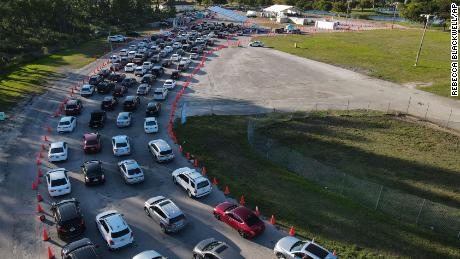
A traveler isolated for Covid-19 at a quarantine facility in New Zealand managed to infect three others across a hallway, researchers reported Thursday.
Closed-circuit camera footage, genetic testing and careful contact tracing show that the only conceivable way the virus could have passed from one room to another was in air that leaked out when both doors were briefly opened, the researchers said.
It’s a demonstration of how the virus can spread — and of how well vaccines can work. The one person who escaped infection was fully vaccinated and never tested positive, despite having stayed in the same room as four other infected people for weeks on end.
Both sets of travelers arrived in New Zealand in mid-July, as the Delta variant of the coronavirus was sweeping the world. One single traveler from the Philippines tested positive during quarantine and was placed into a converted hotel called a managed isolation facility.
A group of five people traveling from the United Arab Emirates also arrived, were quarantined and then one member of the group tested positive, so they were placed in the same facility, across the corridor from the first traveler.
No one was allowed to leave either room, and the doors were opened only for nurse checks and food deliveries — but the doors were not supposed to be opened at the same time. Nonetheless, it did happen, according to Andrew Fox-Lewis of the Counties Manukau District Health Board in Auckland, New Zealand, and colleagues. “Security camera footage revealed four brief episodes of simultaneous door opening during person A’s infectious period,” the team wrote. Each time lasted just a few seconds.
Three more people in the group of five became infected, but genetic testing indicated that their infected companion was not the source. It was the traveler from the Philippines — their virus had the same genetic fingerprints.
Airborne transmission across the hallway is the most plausible explanation, the researchers said. “These findings are of global importance for coronavirus disease public health interventions and infection control practices,” Fox-Lewis and colleagues wrote in the journal Emerging Infectious Diseases.
“Person A was found to have not left the room at any point during their infectious period … and only left the room for exercise after the infectious period, from July 28 onward (after persons B and C had already tested positive),” the team added. It’s possible that this traveler breathed infectious virus into the air of their room, and the air puffed out into and across the hallway when the door was open.
The New Zealand authorities had tried to prevent this with extractor fans and air cleaners, but the system may have failed when the doors opened. “No ventilation systems connected separate rooms. Rooms had external windows that could be freely opened by occupants,” the researchers noted.
“Our findings support the hypothesis that during episodes of simultaneous door-opening, airborne particles in the room of person A rapidly diffused down a concentration gradient, across the corridor, and into the rooms of group BCDEF,” the team wrote.
One person escaped infection: the vaccinated traveler. “Despite sharing a room with four other persons with PCR-confirmed SARS-CoV-2 infection, person F never tested positive for SARS-CoV-2 by (PCR test), testing negative on July 14, 18, 21, 27, 29, 31, and August 8, 14, 16, and 23,” the team wrote.
“Person F had received two doses of the Pfizer-BioNTech COVID-19 vaccine, but no other members of the travel group had been vaccinated.”
It’s not the first time researchers have documented infection via hotel corridor. Coronaviruses can be carried on tiny airborne particles called aerosols, and they infect people when they are breathed in.
Earlier in December, a team in Hong Kong reported that one fully vaccinated traveler infected with the Omicron variant infected another staying in a quarantine hotel there.
“Case-patient A arrived in Hong Kong from South Africa on November 11, 2021, and case-patient B arrived in Hong Kong from Canada on November 10, 2021. Both case-patients had previously received two vaccine doses,” Leo Poon of the University of Hong Kong and colleagues wrote, also in the journal Emerging Infectious Diseases.
“On arrival at the Hong Kong airport, both case-patients stayed in the same quarantine hotel and had rooms across the corridor from each other on the same floor.”
Hong Kong requires many international travelers to quarantine in designated hotels for three weeks.
“No items were shared between rooms, and other persons did not enter either room,” the team wrote.
“The only time the two quarantined persons opened their respective doors was to collect food that was placed immediately outside each room door. The only other time they might have opened their doors would be for (PCR coronavirus tests), which were conducted in three-day intervals. However, because these two case-patients arrived one day apart, it is unlikely that they would be tested on the same day,” they added.
Genomic sequencing made it clear that the two travelers were infected by almost identical versions of the same Omicron virus, the researchers said. Closed-circuit camera footage showed that both had stayed in their rooms, as required.
“Airborne transmission across the corridor is the most probable mode of transmission,” they concluded. “None of the 12 persons staying in nearby rooms on the same floor during the study or related hotel staff have tested positive in repeated tests for SARS-CoV-2.”
As reported by CNN
